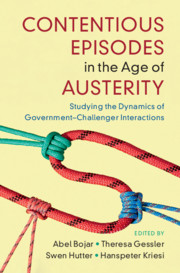 Contentious Episodes in the Age of Austerity
Contentious Episodes in the Age of Austerity from Part III - Dynamics of Interaction
Published online by Cambridge University Press: 05 November 2021
On May 5 and 6, 2010 Greece witnessed extensive protests including a forty-eight-hour nationwide strike and demonstrations in major cities. Protests were provoked by the passing of three austerity measures by the Greek parliament in February 2010, in March 2010, and finally in May 2010. The measures were part of the conditions for the €110 billion first EU bailout, acquired in order to solve the Greek government debt crisis. These events ended with clashes between the police and anti-austerity protesters, during which the police made widespread use of tear-gas and flash bombs, and made multiple arrests. Three people died when some individuals set fire to a bank branch with Molotov cocktails, and tens of people were injured. One year later, the police once again made use of violence against protesters at the May 11 demonstrations. This was a few days before the Greek Indignant Citizens Movement on May 25, 2011 started to protest in major cities across Greece. In June 2011, in concomitance with the government discussions on the midterm adjustment program and additional austerity measures (the adjustment program was later passed on June 29, 2011), police clashed with demonstrators numerous times – again, making excessive use of tear-gas.
To save this book to your Kindle, first ensure [email protected] is added to your Approved Personal Document E-mail List under your Personal Document Settings on the Manage Your Content and Devices page of your Amazon account. Then enter the ‘name’ part of your Kindle email address below. Find out more about saving to your Kindle.
Note you can select to save to either the @free.kindle.com or @kindle.com variations. ‘@free.kindle.com’ emails are free but can only be saved to your device when it is connected to wi-fi. ‘@kindle.com’ emails can be delivered even when you are not connected to wi-fi, but note that service fees apply.
Find out more about the Kindle Personal Document Service.
To save content items to your account, please confirm that you agree to abide by our usage policies. If this is the first time you use this feature, you will be asked to authorise Cambridge Core to connect with your account. Find out more about saving content to Dropbox.
To save content items to your account, please confirm that you agree to abide by our usage policies. If this is the first time you use this feature, you will be asked to authorise Cambridge Core to connect with your account. Find out more about saving content to Google Drive.